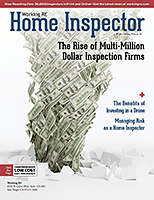 | > E&O/GL Insurance for Home Inspectors Competitive Rates, Broad Coverage, Free Risk Management, online inspection support for tough questions, discounts on education and more… Professional Coverage, Competitive Pricing Shop OREP today! |
The Benefits of Investing in a Drone
By Kevin Hesterberg, The Drone Hangar LLC
I started using drones for my father’s home inspection business in 2018, and since then we have per formed over 1,000 roof inspections using drones. I developed a process for effectively capturing images that allowed my father to not only save time on his inspections, but to reduce the chance of serious injury. This started after he had a ladder fall out from underneath him while inspecting an attic in a garage. I realized that using a lad-der to get onto a roof could possibly be eliminated entirely by using drones.
Like most inspectors, my father didn’t want to trust this relatively new technology blindly, so we devised a test. I would inspect the roof using a drone, he would review the photos, and then he would climb onto the roof to do his normal inspection to compare the two. In those two months he realized that he was seeing more with the drone than he could walking the roof. It wasn’t just the time and safety elements that made using a drone a winner for him, but the viewing angle, capability to access areas he couldn’t otherwise, and being able to inspect every roof regardless of surface, pitch angle, or ground condition.
I began Drone Hangar in 2019 because we realized that no one was discussing using drones for home inspections at that time. Since then, there has been more discussion among inspectors about this amazing technology, however I believe there is some important information that is usually not covered, or even incorrect. For example, I have read articles that have concluded that even though drones are great you should still walk on a roof—I completely disagree.
When I read these articles or talked to inspectors who believed that walking on a roof is still the best way to do it, I found they have a few things wrong. First, having the right drone with the right optics is critical. The saying “garbage in, garbage out” applies here. Optics and camera resolution matter, if you have the wrong optics, then you are losing out on the most important component of a drone. We have found that a 20 Megapixel (MP) sensor is a minimum when inspecting. You can do just fine with a 12 MP, however, to take full advantage of the images, you must be a lot closer to the roof’s surface—which spells trouble for newer pilots. So, if you are considering a drone, make sure you pay close attention to the camera you get.
Second, if you are using the drone like binoculars, you are using it wrong. Are you going to see defects while flying? Yes, however, keep in mind you are distracted because you don’t want to hit a chimney or tree or you are focused on operating the drone (as you should be). Therefore, your chances of missing things are much higher than if you just take images of the entire roof in a logical pattern. You can then view the images on a PC or tablet after the flight. In fact, you’ll be able to zoom in on the images and you’ll be fully focused on the roof inspection. Even when walking on a roof, there is a certain amount of distraction because whether inspectors want to admit it or not, you are thinking about not falling off the roof. Even this subconscious distraction affects your ability to catch small details.
I have spoken at multiple large inspection conferences in the country and had the opportunity to speak to inspectors from all over the world since I began Drone Hangar, and I hear a lot of the same arguments and reasons that walking a roof is still better than using a drone. While I would love to address each one of these concerns, there simply isn’t enough time in this article to do so. However, if you are on the fence, do what we did. Buy the right drone, fly it, and then walk it and compare, or do some more research. I am confident that you will find that the benefits of using a drone are worth the small expense (drone technology has been getting better and cheaper). I am also not saying never to walk a roof, in fact, if you still feel the need to lift shingles or check drip edges, you can use the drone to inspect the roof and then inspect from the eaves from a ladder. The most dangerous part of inspecting a roof is getting on and off the ladder at the top of the roof, so eliminating this will make your inspections safer.
However, do not just get a drone to “use on the dangerous roofs” only. As I just mentioned, getting on and off the ladder is dangerous and there is no such thing as a “safe” roof. If you get a drone, use it on every inspection. When using a drone, you are flying an aircraft (the FAA calls it a small unmanned aircraft), and just like private or commercial pilots, you need to maintain your proficiency through use.
(story continues below)
(story continues)
If you are not using your drone on a regular basis, you are going to be less proficient, less confident, and you are going to make mistakes. If you decide not to use a drone on every inspection, at least set aside the time to take your drone out once a week and practice. I would still recommend that you use it on every inspection, as it can literally save your life.
Did you know that most fall deaths occur at eight feet or less? It doesn’t take a fall from high up to be fatal. Most inspectors don’t regularly inspect their ladders or even take ladder safety classes, and I have seen many inspectors that don’t even tie their ladder off at the gutter. Talk to a firefighter; there is a specific way to set up a ladder and even they know that failing to respect this process can cause injury or death. The bottom line is that you don’t get paid enough to take that risk and your Standards of Practice don’t require it.
In fact, anything that can be deemed dangerous or can cause damage is covered in the exclusions section anyway. If you are the sole provider for your family, what happens if you become seriously injured or permanently disabled? Do you have an adequate disability policy? Do you charge enough to make these risks worth it? I am also sure that your Errors & Omissions (E&O) provider would love to know that they won’t have to pay out any claims because you damaged the shingles when you walked on them. We have actually started to see many inspectors be accused of this. (Many E&O providers now include drone coverage as part of the policy too!)
Now, let me tell a story about something that happened to an inspector in my area this year. He recently fell from a two-story roof while inspecting. He ended up in the hospital with a couple of broken bones and a head injury. Weeks after he was released from the hospital, he was still having headaches. He says he was lucky, and I agree, because it certainly could have been worse. The craziest thing of all was that he owned a drone, and even had it with him that day but decided not to use it because he didn’t consider the roof “unsafe”. He says he is doing fine now, however, injuries can take years to manifest the full extent of the damage. A Traumatic Brain Injury (TBI) can have side effects that are not initially apparent. Memory loss, “foggy thinking,” trouble sleeping, depression, or even personality changes can occur several years after a head injury.
So, what happened? Why did he fall off the roof? What he said to me was what I hear a lot from other inspectors: “I don’t know what happened, next thing I knew I was on the ground”. I think it is safe to say that the ladder slipped, failed, or maybe he miss-stepped. Another story that an inspector told me is that he got up on what he deemed as a “safe” roof, and after taking three steps the granules started to release and it was like “standing on a sheet of ice, on steep hill.” He was able to catch himself on the gutter, where he had to sit and collect himself for about 20 minutes. That was the last roof that he walked. He now uses a drone on every roof that he inspects.
These stories are sadly not unique. I hear variations of these stories from almost every inspector that I talk to, and with the current drone technology that is available, these can be prevented. Whenever I talk to a large group of inspectors, I always like to ask how many inspectors have almost fallen off a roof at least once. Ninety-nine percent of the hands go up.
When I ask how many have been injured falling off a roof, the number of hands that go up is always sobering. If you are worried about learning how to fly a drone, or what you need to know to do so, it’s not as hard as you think. Trust me, your spouse will be okay with you not having to risk serious injury every day, so convincing them that you need to buy a drone will not be as hard as you think. In fact, it is usually the inspector’s spouses/partners telling them to go talk to me at shows.
I am very passionate about reducing the amount of roof-related inspection injuries, so I encourage any of you to reach out to me if you have any questions about this technology. Even if you can’t fly because of airspace restrictions (If you live in D.C. , sorry guys no drones for you), or weather, still consider using a telescoping pole. Between that and inspecting from the eaves (not getting off the ladder), you can still inspect the roof according to your Standards of Practice without risking your life!
About the Author
Kevin has advanced training in Aircraft maintenance through the U.S. Air Force where he served as a crew chief on the F-15. Kevin is a licensed commercial drone pilot, repair technician, and a drone trainer and speaker, providing CE courses on Drones in the inspection business at State and national inspection organizations. Learn more at www.TheDroneHangarLLC.com.
OREP Insurance Services, LLC. Calif. License #0K99465


